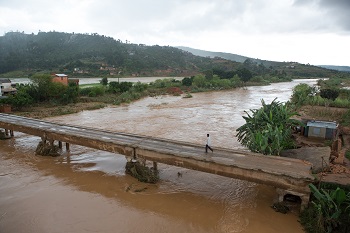UNICEF humanitarian airlift arrives in Madagascar in aid of thousands affected by Cyclone Enawo
A cargo flight carrying 79 tons of humanitarian supplies has arrived in the capital of Madagascar as part of the UN Children’s Fund’s (UNICEF) ongoing response to Cyclone Enawo which caused significant damage in the northeastern part of the country and has affected much of the rest of the world’s fourth-largest island.

26 February, 2016 a flood-affected area near Ampangabe Village in Analamanga Region. Heavy rains during the cyclone season caused extensive flooding that destroyed or damaged homes.
Cyclone Enawo slammed into the northeastern region of Sava on Tuesday 7 March. By Friday 10 March, it had moved off the southern coast of Madagascar into the Indian Ocean after moving down the entire length of the island, dropping heavy rains and causing strong winds.
The supplies, to complement prepositioned relief items, consist primarily of education kits, tarpaulins, essential medicines, diarrheal kits, first aid kits and emergency health kits. They were mobilized by UNICEF’s Global Supply Warehouse in Copenhagen.
As on Mar 17, 246,842 people were reported to have been affected by the cyclone, including 5,194 who remained displaced of a total population of 433,612 who were displaced either directly by the storm or as a safety measure. The number of deaths due to the storm rose to 81, with 18 people missing and 253 injured. Widespread but largely temporary flooding has been recorded in the storm’s wake, with waters receding quickly in many areas. The return of conducive weather conditions by 9 March permitted initial surveys, but the full extent of the cyclone’s impact requires a few more days of assessments to be known, as many of the most heavily impacted areas are remote, with poor telecommunications and road networks. Assessment missions, led by the government through its national disaster office (BNGRC) and supported by UN agencies, NGOs and the Malagasy Red Cross, are ongoing and data is being compiled regularly.
"We are working hand-in-hand with social sector Government of Madagascar counterparts at the national, regional and local levels so that assistance arrives where people need it, as soon as possible," said UNICEF-Madagascar Representative Elke Wisch. "We will continue to work tirelessly to help the people of Madagascar who have been affected by the cyclone – especially children, who are always among the most vulnerable in disasters.”
Madagascar is one of the countries most affected by natural disasters, such as cyclones, droughts, floods, locusts and epidemics.
The southern region of the country has been dealing with a prolonged drought for several years, and the current damage caused by the cyclone in the north has exacerbated the vulnerability of the most fragile populations. Similarly, the damage caused by the cyclone has added to the cumulative effects of years of drought in the south, aggravating the vulnerability of many – all combined, further highlighting the need for longer-term resilience and development efforts.
Madagascar, a nation of an estimated 23 million people, has been hit by 46 natural disasters over the last 35 years, affecting a combined total of more than 11 million people, including more than five million children, and causing an estimated US$1 billion in damages.
Source:United Nations Children's Fund
- 241 reads
Human Rights
Fostering a More Humane World: The 28th Eurasian Economic Summi

Conscience, Hope, and Action: Keys to Global Peace and Sustainability

Ringing FOWPAL’s Peace Bell for the World:Nobel Peace Prize Laureates’ Visions and Actions

Protecting the World’s Cultural Diversity for a Sustainable Future

Puppet Show I International Friendship Day 2020

